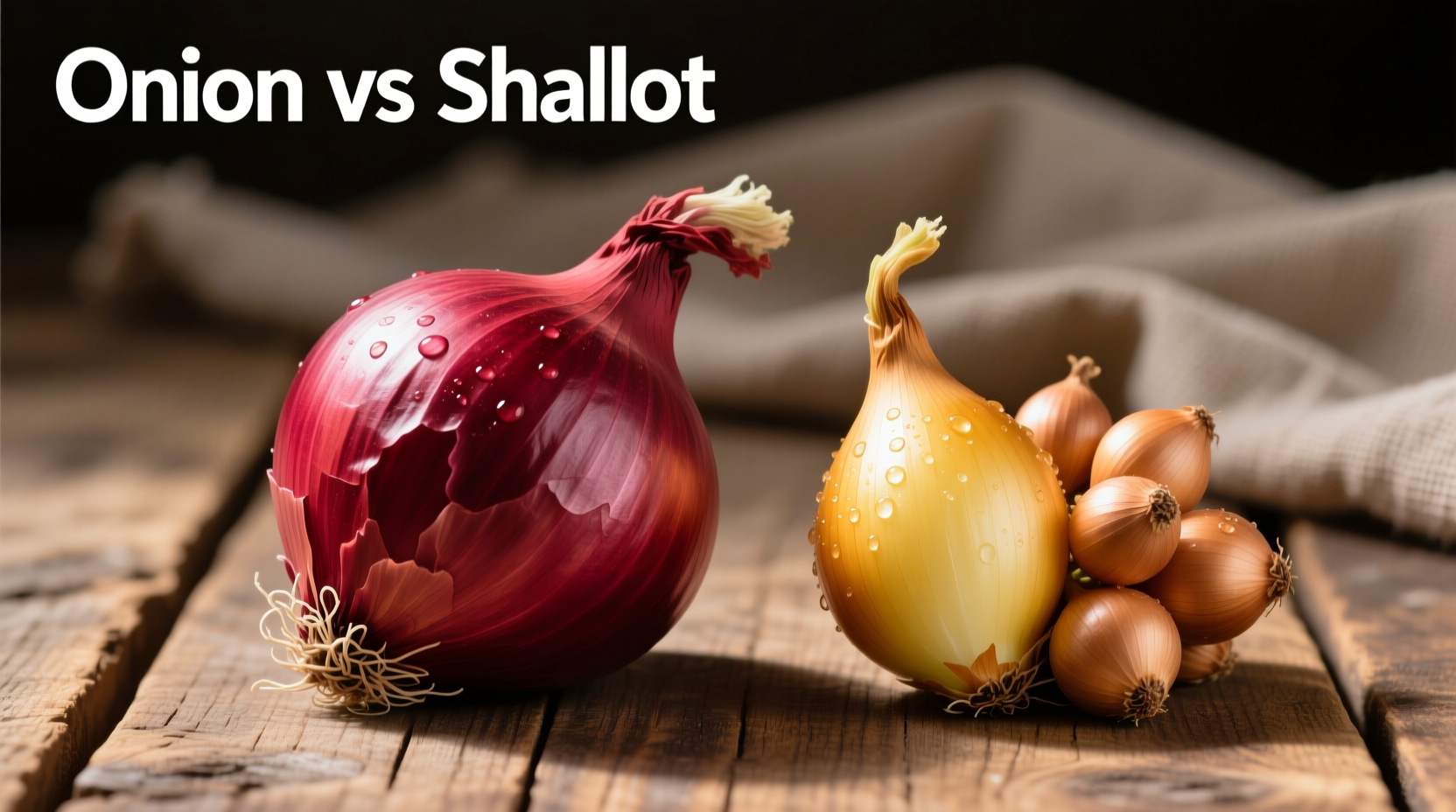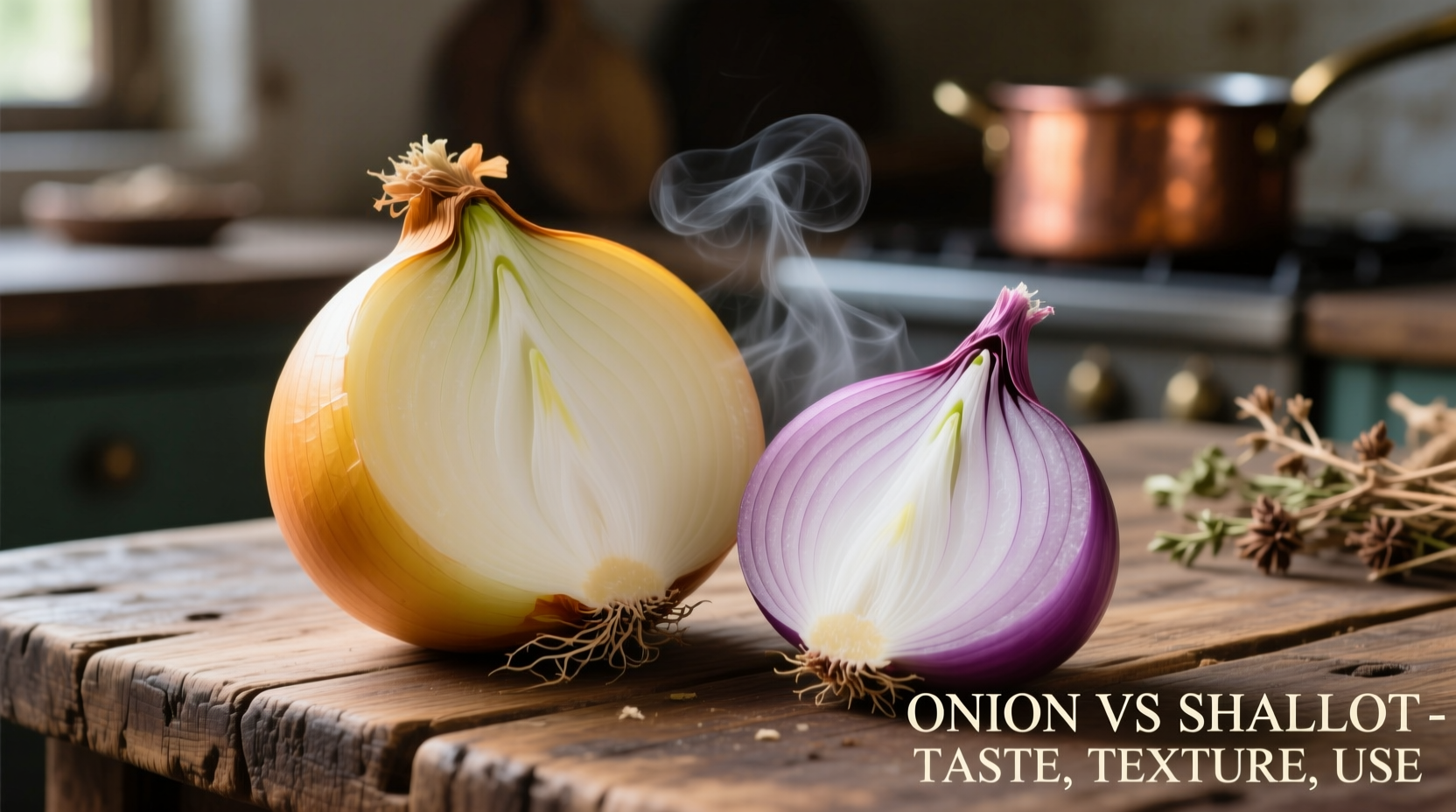Onions deliver a stronger, more pungent flavor with higher sulfur content, while shallots offer a delicate, sweet-onion-garlic hybrid taste with 30% more antioxidants. Use onions for robust dishes like soups and stews; choose shallots for vinaigrettes, sauces, and raw applications where subtlety matters.
Ever stood in the produce aisle wondering whether to grab onions or shallots for your recipe? You're not alone. Professional chefs and home cooks alike struggle with this everyday kitchen dilemma. Understanding the onion vs shallot distinction transforms your cooking from good to exceptional. This guide delivers the precise differences you need to make confident ingredient choices—no culinary degree required.
Spot the Difference: Visual Identification Guide
Before we explore flavor chemistry, let's solve the most immediate problem: telling them apart. Onions typically feature:
- Rounded bulb shape with papery brown, red, or white skin
- Single large bulb divided into concentric layers
- Strong white to purple-tinged flesh
Shallots reveal their identity through:
- Elongated, garlic-like shape with coppery skin
- Multiple cloves clustered together (like garlic)
- Translucent purple-tinged flesh

Flavor Chemistry: Why the Taste Difference Matters
The onion vs shallot flavor profile difference stems from their chemical composition. Onions contain higher concentrations of syn-propanethial-S-oxide—the compound that makes you cry—but also delivers that characteristic sharpness. Shallots contain more fructose (natural sugar) and different sulfur compounds, creating their signature sweet-garlic complexity.
According to USDA FoodData Central analysis, shallots contain approximately 30% more antioxidants than yellow onions, particularly flavonoids like quercetin. This contributes to their milder raw flavor and more complex caramelization when cooked.
Culinary Applications: When to Choose Which
Your recipe's success often depends on selecting the right allium. Consider these professional chef guidelines:
| Dish Type | Recommended Allium | Why It Works |
|---|---|---|
| French Vinaigrettes | Shallots | Melts seamlessly without overpowering delicate oils |
| Beef Stews | Yellow Onions | Withstands long cooking while building robust flavor base |
| Sushi Garnish | Shallots | Raw application where sharpness would ruin delicate fish |
| Caramelized Onions | Yellow Onions | Higher sugar content creates deeper Maillard reaction |
Substitution Science: Making It Work When You're Missing One
Running short on shallots? Need to replace onions? Our onion to shallot conversion guide solves this common kitchen emergency:
- 1 small shallot ≈ ¼ cup finely diced yellow onion (with 15% less volume)
- Raw applications: Reduce onion quantity by 25% and add pinch of garlic powder
- Cooked dishes: Use equal volume but expect more pungent finish
Remember: Substitutions work best in cooked dishes. For raw applications like salads or salsas, the flavor difference becomes pronounced. The Journal of Food Science confirms that cooking transforms the sulfur compounds differently in each variety, altering their final flavor profile.
Nutritional Showdown: Health Implications
While both belong to the Allium family, their nutritional profiles differ significantly. Per 100g serving according to USDA data:
- Shallots: 72mg vitamin C, 16mg calcium, 153mg potassium, 40mg quercetin
- Yellow onions: 10mg vitamin C, 23mg calcium, 146mg potassium, 11mg quercetin
Shallots' higher antioxidant content makes them particularly valuable for raw consumption. However, onions develop additional beneficial compounds when caramelized—the Maillard reaction creates new antioxidant complexes not present in raw form.
Storage Secrets: Maximizing Shelf Life
Proper storage preserves both flavor and nutritional value. Follow these evidence-based guidelines:
- Onions: Store in cool, dark, well-ventilated space (not the refrigerator)
- Shallots: Keep in mesh bag at room temperature away from potatoes
- Never store either near ethylene-producing fruits like apples
- Cut pieces last 7-10 days refrigerated in airtight container
Research from the University of California Cooperative Extension shows that improper storage increases enzymatic browning by 40% in shallots compared to onions, directly impacting flavor quality.
Professional Chef Mistakes to Avoid
Even experienced cooks make these onion vs shallot errors:
- Mistake: Using red onions as shallot substitutes in vinaigrettes
Solution: Red onions bleed color and overpower delicate dressings - Mistake: Cooking shallots as long as onions in reductions
Solution: Shallots burn 30% faster due to higher sugar content - Mistake: Storing cut pieces in water
Solution: Water leaches flavor compounds—use dry container instead
When Subtlety Wins: Signature Dishes Featuring Shallots
Certain recipes showcase why professional kitchens specify shallots. Try these applications where their delicate flavor shines:
- Beurre Monté: Shallots provide aromatic base without overpowering butter
- Coq au Vin: Traditional French preparation requires shallots for authentic flavor
- Raw Sushi Garnishes: Thinly sliced shallots complement fish without harshness
- Delicate Cream Sauces: Onions would dominate where shallots blend seamlessly
When Boldness Required: Signature Onion Applications
Some dishes demand the robust character only onions provide:
- Caramelized Onion Tarts: Onions develop deeper sweetness through extended cooking
- Beef Bourguignon: Yellow onions withstand hours of simmering while building flavor
- Soups and Stews: Onions maintain structural integrity during long cooking
- Pickled Onions: Their stronger flavor stands up to vinegar brine











 浙公网安备
33010002000092号
浙公网安备
33010002000092号 浙B2-20120091-4
浙B2-20120091-4